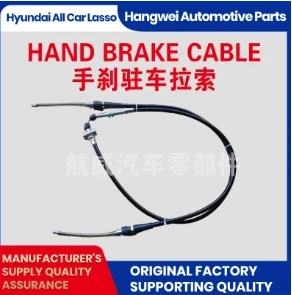Understanding and Maintaining Your Emergency Brake Cable for Optimal Vehicle Performance
Understanding the E-Brake Cable Importance and Maintenance
The e-brake, or emergency brake, is a crucial component of any vehicle's braking system. Also known as the parking brake, its primary purpose is to keep the vehicle stationary when parked and to serve as a backup braking mechanism in case of primary brake failure. One essential component of the e-brake system is the e-brake cable, which plays a vital role in its operation.
What is an E-Brake Cable?
The e-brake cable is typically a steel wire cable enclosed within a protective sheath. This cable connects the e-brake lever, often situated in the vehicle's cabin, to the brake calipers or drums, allowing the driver to engage the parking brake. When the driver pulls the lever, the cable tightens, pulling on the brake mechanism and engaging the brakes to hold the vehicle in place.
Importance of the E-Brake Cable
The e-brake cable is essential for the proper functioning of the emergency brake system. If the cable is damaged, frayed, or rusted, it can lead to the e-brake not functioning as intended. This malfunction can be particularly dangerous, as a vehicle that cannot be securely parked poses risks not only to the vehicle itself but also to pedestrians and other road users. A functioning e-brake system can also be vital in emergency situations, providing the driver with peace of mind that they can stop the vehicle quickly if the primary brakes fail.
Signs of a Failing E-Brake Cable
Several signs indicate that an e-brake cable might be failing. These can include
1. Difficulty Engaging/Disengaging the Brake If the lever feels stiff or does not pull up smoothly, it may indicate that the cable is sticking or damaged. 2. Unusual Noises If you hear popping or grinding noises when you pull the e-brake, it’s a sign that the cable might be frayed or rubbing against other components. 3. Brake Warning Light In some vehicles, a malfunctioning e-brake cable may trigger a warning light on the dashboard, indicating that the system needs attention.
e brake cable

4. Vehicle Rolling While Parked If the vehicle does not remain stationary when in park or shows signs of rolling, it might be due to a failing e-brake cable or other issues within the brake system.
Maintenance of the E-Brake Cable
To ensure that the e-brake cable remains functional and reliable, regular maintenance is key. Here are some tips for maintaining the e-brake cable
1. Inspect Regularly Periodically check the e-brake cable for signs of wear and tear, such as fraying or rust. Look for any signs of corrosion on the hardware as well.
2. Keep it Clean Dirt and debris can hinder the operation of the e-brake cable. Regularly clean the area around the cable and ensure that there are no obstructions.
3. Lubrication Some cables benefit from occasional lubrication to ensure smooth operation. Consult your vehicle’s manual for recommendations regarding lubrication.
4. Seek Professional Help If you notice any signs of wear or if the e-brake cable is not functioning correctly, it’s wise to consult a mechanic. It is better to address issues early to prevent costly repairs or accidents later.
Conclusion
The e-brake cable is a small yet significant part of a vehicle's braking system. By understanding its function, recognizing the signs of failure, and performing regular maintenance, vehicle owners can ensure their e-brake system operates effectively, providing safety and security on the road. Remember, when it comes to braking systems, neglecting small components like the e-brake cable can lead to significant issues, so proactive care is essential.
-
Workings of Clutch Pipe and Hose SystemsNewsJun.04,2025
-
The Inner Workings of Hand Brake Cable SystemsNewsJun.04,2025
-
The Secrets of Throttle and Accelerator CablesNewsJun.04,2025
-
The Hidden Lifeline of Your Transmission Gear Shift CablesNewsJun.04,2025
-
Demystifying Gear Cables and Shift LinkagesNewsJun.04,2025
-
Decoding Clutch Line Systems A Comprehensive GuideNewsJun.04,2025
